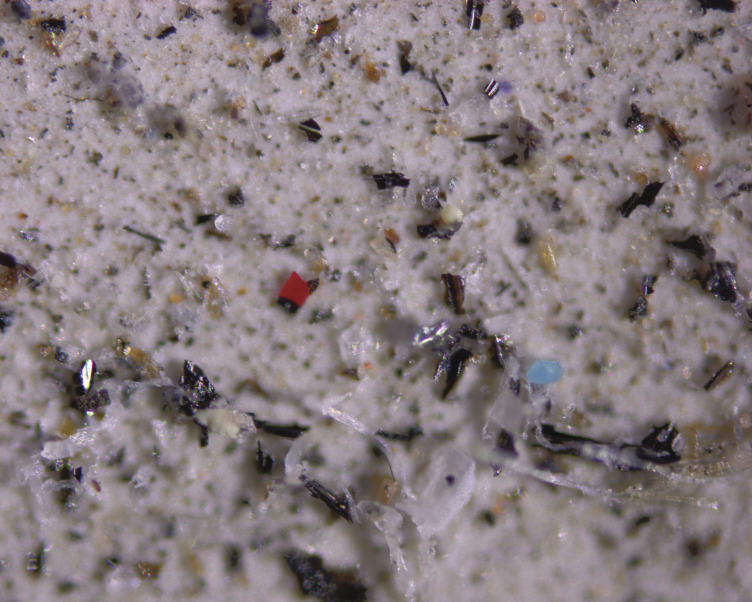ENGINEERING
When stimulated, each electrocyte of the electric eel can generate 150 mV via ion transportation through highly selective ion channels on cell membranes.
Printable power inspired by eels
Printed energy storage devices can provide power to wearable devices. Lu Yang et al. used electric eels, which rely on sodium and potassium ion gradients to generate currents, for inspiration in developing alternatives to hazardous components in batteries. The authors developed two inks from graphene oxide, a permeable material with enhanced conductivity of positively charged ions. The two inks differed in their concentrations of potassium cations. Silver electrodes were also printed onto the paper. When moisture was introduced, reduction and oxidation of the silver produced a current, and potassium ions moved within the 2D nanofluidics in the graphene oxide, generating 1.2 volts per cell. The silver electrodes also served to transform the ion migration into an electric current. When the authors printed 175 of these cells in a series, they generated 192 volts of electricity. In the absence of moisture, such as in a vacuum bag, the voltage was zero. Using this approach, the authors created a 3D cell. According to the authors, the performance of the power source is similar to lithium thin-film batteries and could aid the development of wearable electronics. — T.H.D.
PSYCHOLOGICAL AND COGNITIVE SCIENCES
Geometric intuitions are present in humans but not baboons
Humans are unique among primates in their ability to create formal symbolic systems that capture regularities in the external world. Mathias Sablé-Meyer et al. provide evidence that humans, but not baboons, use a symbolic strategy to process the regularities of geometric shapes, regardless of age, culture, or education. The authors generated 11 quadrilaterals, or four-sided shapes, that varied in their number of geometric regularities, including parallel lines, equal angles, equal sides, and right angles. During each trial, 605 adults were asked to identify a deviant among six shapes presented. Both response times and error rates decreased as the total number of geometric regularities rose. Similar results were observed with 28 kindergartners, 156 first graders, and 22 Himba adults, who were recruited in small villages in Namibia and did not attend a single year of school. By contrast, 11 baboons that were extensively trained on the task and reached a similar accuracy as kindergartners were not sensitive to geometric regularities. The performance of baboons was captured by a simple perceptual model, whereas human behavior was well predicted by a second model that assumes an additional level of symbolic processing of geometric features. The findings reveal a signature of human singularity in grasping abstract geometrical concepts and challenge nonsymbolic models of human shape perception, according to the authors. — J.W.
EARTH, ATMOSPHERIC, AND PLANETARY SCIENCES
Microplastic particles in atmospheric dust.
Microplastics in the atmosphere
Microplastic pollution is a major environmental issue. By combining in situ observations of microplastic accumulation with an atmospheric transport model, Janice Brahney, Natalie Mahowald, et al. examined major sources of atmospheric microplastics as well as the locations where such pollution is concentrated. The authors collected atmospheric microplastics data from the western United States over a 14-month period. Eighty-four percent of atmospheric microplastics came from road dust, whereas 11% came from sea spray and 5% came from agricultural soil dust. Terrestrial microplastic pollution was deposited on ocean surfaces, and oceanic microplastic pollution was deposited on land. Most continents imported more plastic than they exported. Hotspots for terrestrial microplastic sources and accumulation included Europe, Eastern Asia, the Middle East, India, and the United States. Overall, the greatest concentration of atmospheric microplastics was estimated to be over the ocean. Depending on size, microplastics remained in the atmosphere from approximately 1 hour to 6.5 days, the latter duration being sufficient for cross-continental transport. Antarctica also received microplastic pollution from the atmosphere, despite having zero microplastic emissions. The findings suggest that even after atmospheric microplastics settle on land or in water, they may reenter the atmosphere, according to the authors. — M.S.
AGRICULTURAL SCIENCES
Transporter conferring herbicide resistance in plants
The ubiquitous use of the herbicide glyphosate has led to the evolution of dozens of glyphosate-resistant weed species. Lang Pan et al. report that herbicide resistance in plants can be mediated by ABC transporters, which are also implicated in human cancer drug resistance. The plant ABC transporter gene EcABCC8 exhibited up to tenfold higher expression levels in glyphosate-resistant samples of awnless barnyard grass, a species of weed, compared with glyphosate-susceptible samples. Overexpression of orthologous genes of EcABCC8 conferred glyphosate resistance to rice, maize, and soybean and decreased cellular levels of the herbicide by a factor of four. Using the CRISPR/Cas9 gene-editing technique, the authors deactivated the EcABCC8 ortholog in rice, thereby increasing glyphosate susceptibility by a factor of four and doubling cellular levels of the herbicide, compared with genetically unmodified plants. Additional analysis suggested that the EcABCC8 transporter is likely located in the plasma membrane. Together, the findings suggest that the transporter can move glyphosate out of the cytoplasm and into the extracellular space, thereby reducing its toxicity to plants, according to the authors. — J.W.
SOCIAL SCIENCES
Excess mortality in the United States
Compared with other wealthy countries, the United States has higher mortality rates and lower life expectancy. Using 2000, 2010, and 2017 data from the Human Mortality Database, Samuel Preston and Yana Vierboom compared age-specific mortality rates in the United States with the combined mortality rates of France, Germany, Italy, Spain, and England and Wales. The combined population size of the analyzed European regions is comparable to that of the United States. The authors report that compared with the European regions, relative mortality conditions in the United States worsened significantly since 2000 and resulted in more than 400,000 excess deaths in 2017 alone. The same year, US individuals aged 30–34 years were three times more likely to die than their European counterparts. Overall, the United States experienced 13.02 million years of life lost to excess mortality in 2017, which represents a 64.9% increase since 2000, after adjusting for changes in size and age distribution. The findings suggest that the excess mortality rate in the United States in 2017 represents both a larger number of deaths and of lost years of life than those associated with COVID-19 in 2020, according to the authors. — M.S.
ENVIRONMENTAL SCIENCES
Declining winds delay onset of autumnal leaf changes
The timing of leaf coloration change and leaf drop, or foliar senescence, varies each autumn, affecting the annual amount of carbon uptake by trees. Chaoyang Wu et al. report that decreased wind speed in the high northern latitudes is associated with a delayed onset of foliar senescence, extending favorable growth conditions later into autumn. The authors compared the timing of foliar senescence with meteorological data, including temperature, precipitation, cloud cover, and wind speed, in northern areas above 50 degrees latitude from 1982 to 2015. In two meteorological datasets, the authors found decreasing wind speed trends at these latitudes. Foliar senescence was measured with 183,448 historical observations at 2,405 sites. For 29.3% of the sites, wind speed was associated with the onset of foliar senescence. A model that accounted for 31% of the foliar senescence timing showed that wind speed was more likely than temperature or precipitation to be correlated with senescence timing. The authors report that the most likely effect of decreased winds is a decrease in soil drying, which can extend the growing season. According to the authors, the multiple effects of wind on plant growth render it potentially as important to carbon uptake and climate feedback as temperature and precipitation. — T.H.D.
ANTHROPOLOGY

Ancient ostrich eggshells from Ysterfontein 1. Shown are selected eggshells from the top layer of the midden dated by uranium–thorium geochronology, with their outer surfaces facing up. Scale bar: 1 cm.
Dating Stone Age middens using ostrich eggshells
The stratified layers of shell middens formed from cast-off mussel and limpet shells and other artifacts can offer a window into early cultures. However, radiocarbon dating is accurate to only around 50,000 years. Elizabeth Niespolo et al. report a method for dating ostrich eggshells in a Middle Stone Age shell midden and reveal an older and more intensely settled site than previously known. The authors explored a method to precisely date older shell middens and thus allow comparisons among midden sites using debris from a common food source. The authors analyzed 17 eggshell samples from five strata of a midden at Ysterfontein 1, a collapsed rock shelter on the western coast of South Africa. Next, the authors measured the concentration of uranium and thorium, accounted for the secondary uptake of uranium upon burial, and estimated that the midden was formed 119,900–113,100 years ago. Analysis of stable carbon, oxygen, and nitrogen isotopes within the eggshells offered insight into the paleoenvironment, indicating a cooling and drying climate. According to the authors, the accumulation rates of debris within the midden are more akin to those from the Later Stone Age, indicating that humans were intensively foraging marine resources. — T.H.D.
ANTHROPOLOGY
Findings from this cave site in coastal Kenya offer a new perspective on the transition between the Middle and Later Stone Age. Image credit: Ceri Shipton.
Small, sharp blades mark the change from Middle to Later Stone Age in coastal Kenya
Posted on April 9, 2021
Amy McDermott
The transition between the Middle and Later Stone Age is a controversial topic among archeologists. Recent findings offer a possible answer, suggesting that the shift occurred between 67,000 and 71,000 years ago, and has as its hallmark a sudden abundance of small, sharp, fine-grained stone tools. “There was no universally accepted definition of the Later Stone Age before this,” says lead author Ceri Shipton, an archaeologist at University College London in the United Kingdom. Continue Reading





